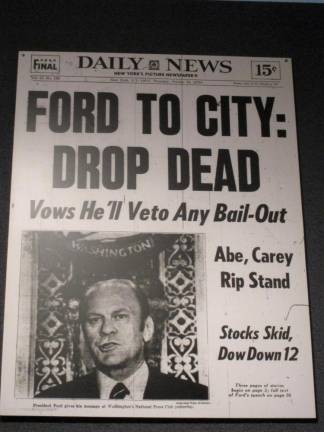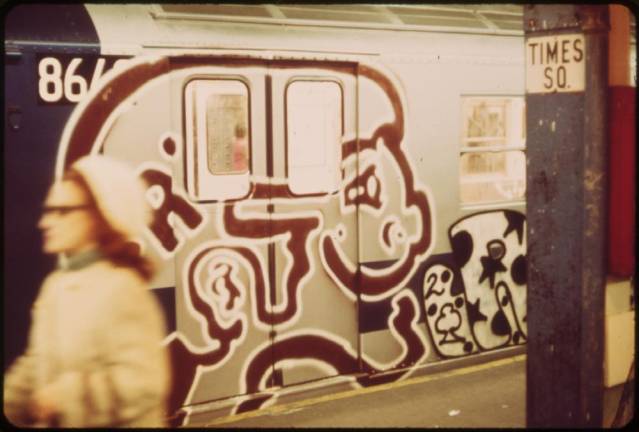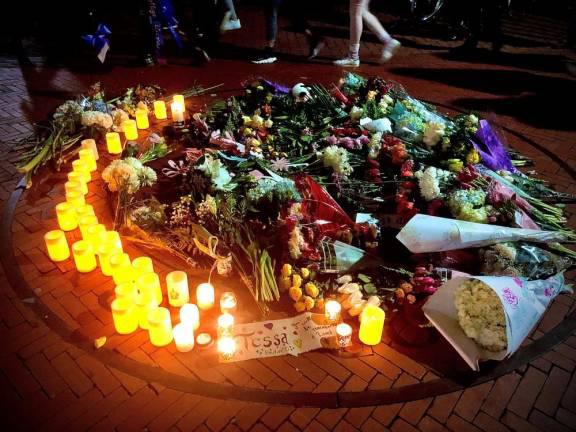Haunted by the '70s
What is it about these days that has so many New Yorkers thinking about those days?



Perhaps it’s nostalgia through a darkened lens, like Brits remembering the Blitz. That was a bad time, but we made it through, together. Or maybe it’s a communal PTSD, in which our collective conscience, the hive brain of the metropolis, is triggered by even a flicker of that fire last time. The siren in the night announcing that the Bronx is burning, again.
Wherever it is coming from, there is no doubt that the Great City is experiencing a bout of reminiscence for a time when crime was rampant, challenges seemed existential and more than half the people of today’s city had yet to be born.
The references are everywhere, in images as much as in words. Movie production designer Mark Frieberg conjured dystopia for “Joker” by recreating New York in the 1970s, with its “crime and corruption and a basic unraveling of the systems that run us.”
He trucked in trash to litter present day streets and when that wasn’t jarring enough, he built an anxiety prompting “Gotham Square” as a haven of sex, drugs and violence. This was no cartoon Gotham City. This was a recognizable and intentional echo of Travis Bickle’s New York. “The City is a character in the story,” Frieberg, born and raised in New York, told Indiewire.
The Risk of Slipping Back
The main square of “Joker” vividly recreates the Times Square captured in two recent documentaries of New York, one by Oren Jacoby and the other by Alice Elliott.
Both films are tales of recovery, of Phoenix rising.
In Jacoby’s, the Broadway theatre staggers through the bad times and emerges more vibrant and creative than ever. In Elliott’s, the financial strain of near bankruptcy causes the city and real estate developers to invent something clever and new, a housing project for artists, Manhattan plaza.
Perhaps these reminders of how bad it once was have heightened our sensitivity to the risk that we could be slipping back. The murder of Tessa Majors on the edge of the Columbia campus was unavoidably seen in the context that measures of various crimes have been edging up (from historically low to nearly historical lows).
“THEY’RE BAAACK!,” The Post exclaimed the other day. “Squeegee men from bad old days harassing NYC drivers.” The editors at the New York Post are master craftsmen of this fearful narrative. They regularly publish a small box with various columns that says simply: “Save our City.” It isn’t always clear who or what we are saving the city from, although the feckless mayor is a leading character.
Yet the Post is not alone in expressing anxiety about a changing city. “I grew up in a different New York,” Ed Kosner, former editor of both Newsweek and the Daily News, writes in the new issue of Commentary, a magazine with unimpeachable credentials for both neoconservative thought and New York roots.
It has been a very long time since a ten-year old Ed Kosner rode the subway by himself, a reflection of both a changing city and changing notions of raising kids. Kosner allows that life has always been fraught here:
“Still, New Yorkers didn’t bargain for what they’re seeing these days. They don’t want the subways to break down so often or to spot a rat scurrying along with a pizza crust or to get slugged on the platform or shoved on the tracks by some mumbling paranoid nut. They don’t want to hurry under the construction platforms that leave the sidewalks permanently in gloom, and they don’t want pieces of buildings to fall on them or their grandchildren. They don’t want to be confronted by a phalanx of panhandlers on the prime shopping blocks of Fifth Avenue or groped by a moocher costumed as Captain America in Times Square. Or see men peeing on the sidewalk. The Manhattan skyline is now disfigured by the needle skyscrapers of Billionaires Row along 57th Street, money-laundering machines full of unsold apartments or vacant pied-à-terre of Ukrainian oligarchs and Malaysian Midases.”
A Great Experiment in Diversity
Every word of this is fact, yet it somehow fails to capture the full story of a city that has grown by more than a million people since 1980, welcoming newcomers from around the country and around the world. With all its stress there must be something that attracts them?
(In the past year or two the population growth appears to have stopped, perhaps even reversed. That decline of perhaps 80,000 could be a warning, although it pales to the 800,000 person decline across the 1970s.)
The huge wealth that has clearly accumulated here in recent years is a challenge to our sense of equity, democratic fair play and even what it means to be New York. Why, New Yorkers are asking, was $25-billion dollars spent to build a suburban shopping mall and attendant office towers and glass draped apartments atop a rail yard?
But this struggle with exaggerated wealth is, as they say, a good problem to have. Or at least a better problem than the days when real estate owners torched their own buildings because the insurance was a better deal than keeping the buildings.
Maybe the truth – if there is one truth – is not that New York has gotten worse but that New Yorkers are getting better. We represent one of the great experiments in diversity anywhere on earth. While this creates great frictions at times, it is also the root of a powerful empathy. Tessa Majors’ death was rightly seen as a terrible tragedy. But at the same time, New Yorkers were able to hold in their heads – or hearts – that it was also a great tragedy that the accused were middle school boys aged 13 and 14.
We demand more from the city than we used to and put up with less. In 1961, it took Jane Jacobs and her shoe leather to discover that many New Yorkers were dissatisfied with supposedly beneficial housing that in fact cut them off from street life. But last year a single random gunshot and the power of social media was all a group of West Side Moms needed to mobilize for their right to safe access to public space
One of the organizers, Elizabeth Carr, cut through the political debates and long-term statistical comparisons in explaining why the group moved so quickly against the return of what were once called “quality of life” crimes. “It’s not okay,” she said.
Simple advice from a parent to her city.
Maybe the truth – if there is one truth – is not that New York has gotten worse but that New Yorkers are getting better.